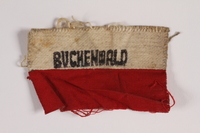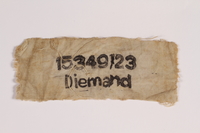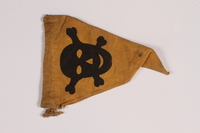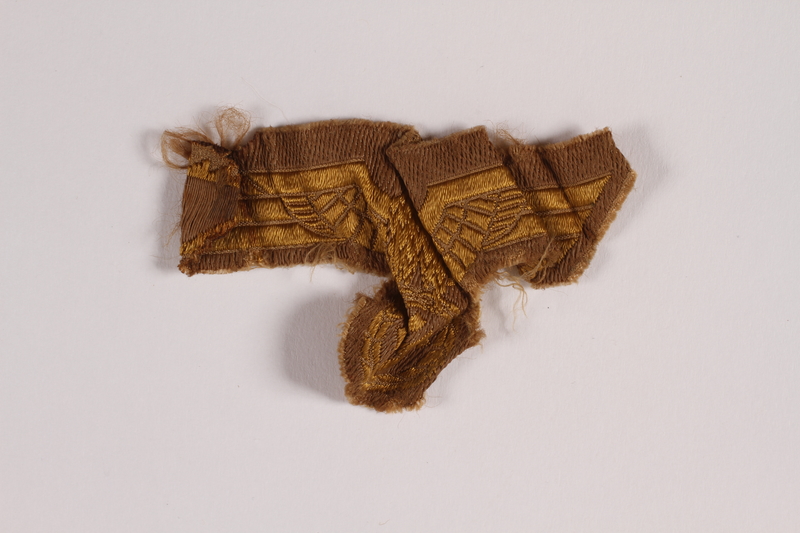Overview
- Brief Narrative
- Unevenly cut, embroidered cloth patch with a gold Reichsadler, or Imperial Eagle, found by Symcho Dymant after he was liberated from Buchenwald concentration camp on April 11, 1945. When Germany invaded Poland on September 1, 1939, Symcho was living in Czestochowa with his wife Tonia and 3 year old son Aaron. The family was forced to move into the ghetto after it was established in April 1941. Symcho escaped and, because he spoke German, was able to get a civilian job in a German military installation by assuming the identity of a non-Jewish Polish person. In September 1942, Tonia, Aaron, and the rest of Symcho’s family were sent to Treblinka and killed. The SS discovered that Symcho was Jewish and he was deported to Buchenwald in Germany, arriving on December 24, 1944. He was assigned prisoner number 15349 and was a slave laborer in a nearby military factory. On April 11, 1945, Symcho was liberated by American forces. He lived in Fulda displaced persons camps before joining Kibbutz Buchenwald. The rabbi of the kibbutz arranged for the kibbutz members to emigrate to Palestine in September 1945.
- Date
-
found:
after 1945 April 11-before 1945 September
- Geography
-
found:
Germany
- Credit Line
- United States Holocaust Memorial Museum Collection, Gift of Dr. Jacob Dimant
- Contributor
-
Subject:
Simcha Dimant
- Biography
-
Symcho Dymant was born on February 18, 1913, in Warsaw, Poland, to a Jewish couple, Aharon and Keila Wislicki Dymant. He had three siblings: Alexander, Hindi, and another brother. Aharon, a watchmaker, died in 1915 and Keila died when Symcho was young. He was raised by his grandmother in Sosnowiec. Symcho became a carpenter and settled in Czestochowa. On August 23, 1936, he married Tonia Wargon. They had a son, Aaron, in September 1937.
On September 1, 1939, Germany invaded Poland. They occupied Czestochowa on September 3. Symcho and his family were forcibly moved into the ghetto after it was established on April 9, 1941. Symcho was involved in the underground resistance in the ghetto. Symcho escaped the ghetto. Because he spoke German, he was able to get a civilian job under an assumed identity as a non-Jewish Polish person in a German military installation near the town. In September 1942, the Germans decided to destroy the ghetto. On September 22, Symcho’s mother-in-law was shot in the head by Nazi officials. Symcho’s wife Tonia, 4 year old son Aaron, and all of his relatives were sent to Treblinka killing center. In May 1943, a sympathetic German officer helped Symcho send his sister-in-law, Hela Wargon and her husband Karl, in New York a letter explaining the deportation of the family. The SS discovered that Symcho was Jewish. He was also charged with political crimes and deported to Buchenwald concentration camp in Germany. He arrived on December 24, 1944, and was assigned prisoner number 15349. He was a slave laborer in a nearby military factory. He was active in resistance in the camp. On April 11, 1945, the camp was liberated by American troops.
Just after the war, Symcho worked for the Allied Expeditionary Force, traveling through Germany gathering information on refugees from concentration camp. Symcho moved to Fulda displaced persons camp by the summer. He joined Kibbutz Buchenwald, which was established on a farm by sixteen camp survivors. He met Ita Rozenczwajg (1918-2010). She had survived by living under an assumed identity as a non-Jewish Polish person and was sent to Germany as a Polish forced laborer in 1943. There were two rabbis associated with the group. One went to the British embassy in Paris to get certificates for emigration to Palestine. On September 8, 1945, eighty young men and women from the Kibbutz arrived in Haifa, one of the first large survivor's group to reach Palestine. Symcho changed his name to Simcha Dimant. In 1946, Simcha and Ita married. The couple had two sons. Simcha, age 70, died in 1983.
Physical Details
- Classification
-
Identifying Artifacts
- Category
-
Badges
- Object Type
-
Badges (lcsh)
- Physical Description
- Small, brown, cloth patch with an eagle with outspread wings holding a wreath with a swastika machine embroidered in gold thread. The edges are uneven and jagged and there are loose threads. It appears to have been cut out of a section of cloth or other material.
- Dimensions
- overall: Height: 1.625 inches (4.128 cm) | Width: 3.625 inches (9.208 cm)
- Materials
- overall : cloth, thread
Rights & Restrictions
- Conditions on Access
- No restrictions on access
- Conditions on Use
- No restrictions on use
Keywords & Subjects
- Topical Term
- Concentration camp inmates--Germany--Biography. Holocaust, Jewish (1939-1945)--Poland--Czestochowa--Personal narratives. Holocaust survivors--Israel--Biography. Jewish refugees--Palestine--Biography. Jews--Persecution--Poland--Czestochowa--Biography. Slave labor--Germany--Biography. World War, 1939-1945--Refugees--Israel--Personal narratives.
Administrative Notes
- Legal Status
- Permanent Collection
- Provenance
- The badge was donated to the United States Holocaust Memorial Museum in 2014 by Dr. Jacob Dimant, the son of Simcha Dimant
- Funding Note
- The cataloging of this artifact has been supported by a grant from the Conference on Jewish Material Claims Against Germany.
- Record last modified:
- 2023-08-30 16:19:29
- This page:
- https://collections.ushmm.org/search/catalog/irn107246
Also in Simcha Dimant collection
The collection consists of a Nazi insignia, two prisoner badges, a German mine warning pennant, and two documents relating to the experiences of Symcho Dymant during the Holocaust in Buchenwald concentration camp, and after the Holocaust in Fulda displaced persons camp in Germany.
Date: 1944 December-1945 July

Red and white patch stenciled Buchenwald worn by a Polish Jewish inmate
Object
Red and white prisoner patch stencilled Buchenwald worn by 31 year old Symcho Dymant while he was an inmate in Buchenwald concentration camp from December 24, 1944, to April 11, 1945. Germany invaded Poland on September 1, 1939, and occupied Czestochowa where Symcho lived with his wife Tonia and 3 year old son Aaron. The family was forced to move into the ghetto after it was established in April 1941. In spring 1942, the Germans decided to destroy the ghetto and began large scale deportations. Symcho escaped, probably in September. He assumed the identity of a non-Jewish Polish person and, because he spoke German, was able to get a civilian job in a German military installation. In September 1942, Tonia, Aaron, and the rest of Symcho’s family were sent to Treblinka and killed. The SS discovered that Symcho was Jewish and he was deported to Buchenwald in Germany, arriving on December 24, 1944. He was assigned prisoner number 15349 and was a slave laborer in a nearby military factory. On April 11, 1945, Symcho was liberated by American forces. He lived in Fulda displaced persons camps before joining Kibbutz Buchenwald. The rabbi of the kibbutz arranged for the members to emigrate to Palestine in September 1945.

White patch with prisoner number and name worn by a Polish Jewish inmate
Object
White cloth badge stencilled 15349123 worn by 31 year old Symcho Dymant while he was an inmate in Buchenwald concentration camp from December 24, 1944, to April 11, 1945. When Germany invaded Poland on September 1, 1939, Symcho was living in Czestochowa with his wife Tonia and 3 year old son Aaron. The family was forced to move into the ghetto after it was established in April 1941. Symcho escaped and, because he spoke German, was able to get a civilian job in a German military installation by assuming the identity of a non-Jewish Polish person. In September 1942, Tonia, Aaron, and the rest of Symcho’s family were sent to Treblinka and killed. The SS discovered that Symcho was Jewish and he was deported to Buchenwald in Germany, arriving on December 24, 1944. He was assigned prisoner number 15349 and was a slave laborer in a nearby military factory. On April 11, 1945, Symcho was liberated by American forces. He lived in Fulda displaced persons camps before joining Kibbutz Buchenwald. The rabbi of the kibbutz arranged for the members to emigrate to Palestine in September 1945.

Yellow warning skull and crossbones pennant found by a concentration camp inmate after liberation
Object
German military issue, poison gas warning pennant found by Symcho Dymant after he was liberated from Buchenwald concentration camp on April 11, 1945. The pennants were attached to a thin, iron rod and staked into the ground. They were used to mark off areas contaminated with dangerous gas, and later repurposed to warn against hidden landmines. The pennants were part of a set that included 20 flags each attached to a 60-cm-long iron rod, painted with red anti-rust paint, a roll of yellow tape, and a carrying pouch. When Germany invaded Poland on September 1, 1939, Symcho was living in Czestochowa with his wife Tonia and 3-year-old son, Aaron. The family was forced to move into the ghetto, after it was established in April 1941. Symcho escaped and, because he spoke German, was able to get a civilian job in a German military installation by assuming the identity of a non-Jewish Polish person. In September 1942, Tonia, Aaron, and the rest of Symcho’s family were sent to Treblinka and killed. The SS discovered that Symcho was Jewish and he was deported to Buchenwald in Germany, arriving on December 24, 1944. He was assigned prisoner number 15349, and was a slave laborer in a nearby military factory. On April 11, 1945, Symcho was liberated by American forces. He lived in Fulda displaced persons camps before joining Kibbutz Buchenwald. The rabbi of the kibbutz arranged for the kibbutz members to immigrate to Palestine in September 1945.




